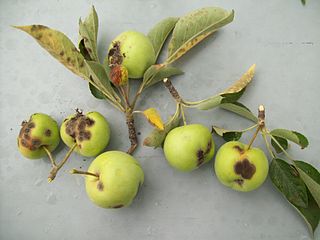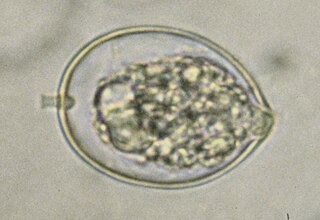Disease management
There are several methods available in order to control black pod disease such as cultural, chemical and biological control. In addition, the cultivation of varieties that resistant to black pod is an alternative in order to reduce disease incidence.
Cultural control
Several cultural practices to manage black pod disease could be implemented in cocoa plantation. [4] A spacing of 3.1 x 3.1m and pruning of trees are recommended for cocoa planting in order to allow more light and air flow around the trees. This will reduce the level of humidity that is causing black pod disease. The removal of pods with black pod symptom should also be done in favor to eliminate the source of inoculum. In another study, the utilization of litter mulch under cocoa plantation has been reported in Papua New Guinea, which has some negative effect on the population of P. palmivora, and therefore could reduce the pod infection especially at the beginning of raining season. Leaf litter showed rapid decline in pathogen recovery of colonized cocoa tissue after 18 weeks, relative to grass ground cover. [16] An explanation for this is due to higher moisture content and microbial activity of other microbes under leaf litter that reduces the survival of Phytophthora cinnamomi as documented by Aryantha et al. (2000). [17] More frequent ripe pod harvest (i.e. twice a week) and removal of infected pod on the ground was demonstrated to significantly reduced disease occurrence and improve pod yield compared to less frequent harvest and removal (i.e. once a month). In addition, scattered healthy pod on the ground should also be removed, as it will be infected and become the source of inoculum later. [18] Sanitation is one cultural method to control for black pod disease. Sanitation practices include weed removal, pruning, thinning and removal of infected and mummified pods every two weeks [7] in order to eliminate the source for inoculum. Phytosanitary pod removal was observed to significantly reduce disease occurrences by 9–11% to 22–31%, where this practice removes the source for secondary inoculum. However, increase in disease incidence after raining season was observed to be most likely due to the spread of inoculum from survival site by the rain. The application of fungicide following sanitation is commonly performed for an effective control of disease, as sanitation practice alone would not eliminate the source of inoculum and still causes greater black pod incident compared to sanitation followed by at least one fungicide application [7]
Chemical control
The application of copper fungicide has been shown to significantly reduce a great number of black pod incidences[ spelling? ] in Nigeria. Metalaxyl (Ridomil) and cuprous oxide (Perenox) were identified to be successful in increasing the number of harvested healthy pod compared to the application of fosetyl aluminium (Aliete) and control treatment. On top of that, the timing of fungicide application has some positive effect on the final pod yield where this plot produced greater yield than the unsprayed plot. The application was done before August, which is before the main disease epidemic that usually occurs in September and October. [8] The recommended standard for fungicide application to control black pod disease caused by P. megakarya for a season is 6 to 8 times of application in every 3–4 weeks. However, the adoption of recommended application was very low among farmers in Ghana. Therefore, an experiment with a reduced number of fungicide applications demonstrated that there was 25 to 45% reduction in disease incidence. [7] In terms of disease control and yields, sanitation and three applications of Ridomil 72 plus (12% metalaxyl + 60% copper-1-oxide) fungicide showed a better control compared to sanitation alone and sanitation with one or two fungicide applications. However, reduced in fungicide application was shown to be significantly less effective than the recommended standard fungicide application. It was suggested that the understanding regarding the source of inoculum, the amount of infective inoculum production and how the disease is disseminated is important in order to identify the appropriate and economical method in fungicide application as well as for an effective control of the disease. For example, the application of fungicide on the trunk will help farmers to control the spread of the disease up in the canopy, as it is difficult to reach the canopy during fungicide application. This will eventually save more time, labor and cost for disease management. [7]
Cultural and chemical control
In Ghana, a study that combined the sanitation and fungicide application showed a significant reduction in the percentage of disease incidence, where greater black pod incident were observed from pods on the trunk than the canopy in control treatment (no fungicide application). This suggested that the application of fungicide on the trunk would protect pods from infection, therefore reduce primary and secondary infection rate, both on the trunk and in the canopy. In addition, the application of systemic (potassium phosphonate) with one and double injection (20 ml and 40 ml of fungicide for each injection frequency), and semi-systemic (metalaxyl) fungicide showed better control compared to contact fungicides (copper based fungicide) in both locations that were used in the experiment. [7]
Biological control

Heavy application of chemical fungicide eventually leads to resistance in pathogens and causes soil and water pollution. Hence, more sustainable and environmental friendly method should be established and implemented, such as biological control. Several species of fungi from the genera of Trichoderma were identified to be beneficial endophytes to control black pod caused by Phytophthora spp. An isolate of Trichoderma asperellum from soil was observed as a potential mycoparasite for P. megakarya where this fungus has the potential to reduce black pod incidence under field conditions in Cameroon. It was reported that moderate black pod cases (47%) occurred in the T. asperellum treatment compared to untreated trees (71%) and chemical fungicide (1.73%). [19] Another species, T. virens, also has been documented to reduce black pod incidence in Peru. [20] In Brazil, a new species known as Trichoderma martiale Samuels, sp. nov. was identified as an endophyte on cocoa, which has the ability to reduce black pod symptoms caused by P. megakarya. [21] This endophyte species survives on cocoa pods, and has the ability to establish a long endophytic association with the host (about 3.5 months). Nevertheless, the protection against black pod via biological control is not as effective as the control using chemical fungicides. [19] [21]
Resistant variety
There is no specific variety of cocoa that shows resistance to Phytophthora infection, and the establishment and utilization of resistant varieties most likely depends on the region. Numerous breeding programs have been established worldwide in order to screen and test local hybrids for resistance to Phytophthora spp. For example, a study in Cameroon assessed the performance of local cocoa cultivars (the southern and northern Cameroon cultivar) compared to the local and international gene bank cultivars. The local genebank cultivar consisted of F1 hybrid of Upper Amazon X Trinidad, and an international cultivar from Papua New Guinea and Latin America were provided through International Cocoa Genebank, Trinidad. Based on the information provided by farmers and leaf disc tests to assess resistance, the local cultivars selected from farmers field showed greater resistance to P. megakarya compared to others. Thus, it was concluded that there are some potentially resistant varieties available in this area. [22] In addition, further work towards developing black pod-resistant varieties is being done by CEPLAC (Executive Plan of Cocoa Farming) agency in Brazil [23] and hopefully more breeding program focusing on black pod resistant will be established to produce commercialized resistant varieties.















